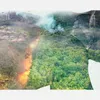Technology—bane, boon, and hope as well
Technology plays a pivotal role in intervention and creation of impact while tackling the new-age challenge of conservation of nature.
Pick any modern-day challenge, and invariably the thought of technology comes to the mind—be it for the collection of data, designing an intervention, or for the solution itself. It is true for the challenges faced in conservation of nature as well.
If we look back at the history of conservation, technology played a pivotal role in not just informing us about the seriousness and urgency of the issue but also in giving us tools to mitigate them. Without technology, we would have not been able to identify threats such as climate change and loss of biodiversity, although some may argue that challenges arose because of excessive use of technology. Either way, if we need to find solutions to new-age challenges, technology will play a pivotal role.

Technology in nature conservation
Conservation of nature requires developing an understanding of the biological aspects of wildlife, ecosystems, and various facets of human behaviour. Technology provides important tools for gathering data. The advancements in both hardware and computing power have opened up avenues of possibilities, which were a dream a decade ago.
Now researchers are able to reach areas that were impossible to reach, such as the ocean floor and deep caves, observe behaviour remotely, and, very importantly, analyse large, complex datasets. Technology has also provided tools to intervene to create an impact.
Camera traps
Camera traps have evolutionised the nature conservation space in numerous ways. They are self-operating cameras that trigger themselves to capture pictures of warm-bodied animals that move in front of them. These images are then used to estimate the population of the target species.
India’s tiger population estimation is probably the world’s largest exercise in the population estimation of tigers. Cameras are used, along with AI, to identify poachers and illegal wood-cutters, and monitor wild animals, especially tigers and leopards that may enter human settlements. In India, Corbett Tiger Reserve has installed a set of cameras—from thermal to visual—to monitor fires, illegal human movement, and movement of wild animals such as elephants and tigers.
Drones and rovers
Other hardware that have been used a lot, of late, are drones and underwater rovers. Drones are not only used for surveillance and mapping exercises but are also used for spotting wild animals. In the Indian context, drones have limited use due to dense canopies and a limit on flying time. Underwater rovers are expensive and have limitations that result in limited use, especially in India.
Geographic information system
Geographic information system (GIS) has revolutionised conservation. GIS creates, manages, analyses, and maps all kinds of data. It provides the foundation for any kind of mapping and analysis of complex, multilayered data.
For example, satellite data of the last five decades can be used to see how land use and land cover have changed over time. It can map rates of degradation of ecosystems, identify priority areas, and map animal movement patterns.
Genetics
Conservation genetics uses cutting-edge technology to understand species taxonomy, study extinction, and learn about population connectivity and corridors. It also helps in understanding environmental stochasticity, such as fires and cold temperatures.
Forensic genetics can play a key role in addressing wildlife crime. Another major contribution of genetics is in devising management practices for ecosystems at large landscape levels.
Benefits of technology
The list of technological applications is long and ever-expanding. Machine learning, data mining, and computer vision have brought forth understanding that was impossible to generate earlier.
Technology has helped reduce inaccuracies and made explorations in inaccessible areas possible. It has helped us make informed choices and evidence-based interventions. Technology provides us with the tools that are adaptive, reduce time, and improve chances of success manyfold.
Technology is at the core of The Habitats Trust. All our programmes are strengthened by it. We are working in the space of computer vision for better understanding of species, acoustic monitoring for elusive species, testing the use of underwater rovers, using satellite imagery and geographic information systems for land use and land cover mapping, and much more.
Though technology is not a magic wand, it does provide hope to successfully address some of the most pressing challenges, including climate change and loss of biodiversity, which directly impact our economy and wellbeing.
Edited by Swetha Kannan
(Disclaimer: The views and opinions expressed in this article are those of the author and do not necessarily reflect the views of YourStory.)







